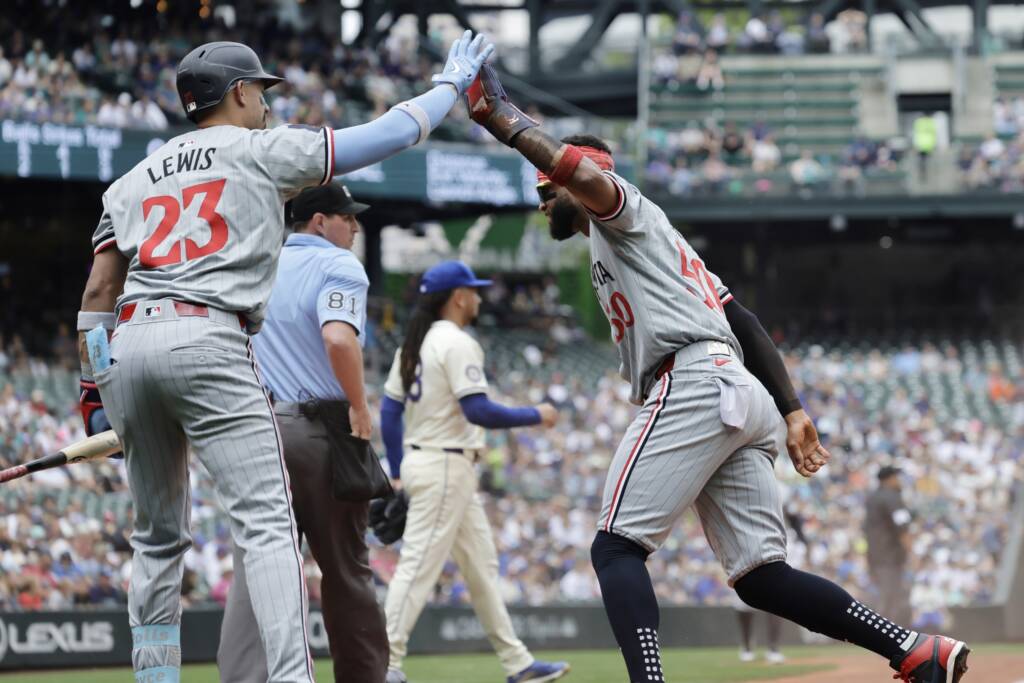It’s no secret that the Minnesota Twins bullpen has taken much of the blame for the team’s downward spiral over the last month. The team has had a 10-19 record since Aug. 18, and their bullpen has a 5.25 ERA in that span, which ranks 26th in baseball. It was again the blame for another bullpen meltdown Wednesday night, where Twins relievers surrendered three runs in the bottom of the 10th inning to lose 5-4 to the Cleveland Guardians.
Injuries have sidelined Minnesota’s veteran bullpen options like Brock Stewart, Kody Funderburk, and Justin Topa. The Twins have removed some relievers from their major-league roster, like Jay Jackson, Steven Okert, or lone trade deadline acquisition Trevor Richards. Caleb Thielbar has regressed from their top lefty to a lower-leverage role. Other young arms like Jorge Alcala and Ronny Henriquez have found some success but have been unable to string consistent outings together.
Over the past month, Minnesota’s relievers have sunk the team from defending their AL Central to hanging on for one of the last two AL Wild Card spots. Suddenly, the red-hot Detroit Tigers are pressing the Twins for their playoff spot by going 13-7 in their previous 20 and now are just a half-game back of Minnesota for the final playoff spot.
But Minnesota’s relievers had a 3.84 ERA, 13th in baseball, before this stretch. The bullpen has imploded. Still, it’s essential to know why. Is the Twins bullpen suddenly bad? Or is it just caught in a month of lousy luck?
Fielding independent pitching (FIP) is a stat that uses the ERA scale to try and separate a pitcher’s production from events that are in a pitcher’s control. Then, xFIP uses that same stat and adjusts it to home run rate rather than actual home runs, counting for 10.5 percent of all fly balls induced. In the first half of the season, the Twins bullpen’s 3.95 xFIP was the 11th-best in baseball. However, in the second half of the season, the Twins have been a top-10 bullpen with a 9th-ranked 3.82 xFIP.
How can Minnesota’s bullpen be pitching so poorly but have it not reflected in their FIP numbers?
Minnesota’s relievers have given up more home runs in the second half. Their 1.10 HR/9 since the All-Star Break ranks 12th-worst in baseball, which doesn’t help. However, the biggest issue comes from runners on base. Since mid-July, the Twins bullpen has had a 1.34 WHIP, bottom-10 in the majors. More runners on base means a higher chance those runners get home.
A sign of a solid bullpen is their numbers with inherited runners. Managers deploy good relievers with men on the bases and expect them to prevent them from scoring. However, Minnesota’s 42 percent inherited runner-scoring rate has been the worst in baseball this year.
Minnesota’s relievers have failed to strand runners when they’ve most needed to this season. David Festa and Zebby Matthews have filled Joe Ryan and Chris Paddack’s spots in the rotation after they suffered injuries. In doing so, the Twins are asking the bullpen to pitch more innings to accommodate the volatility of rookie pitchers, and it has worn a thin group to its limit.
During the All-Star Break, Minnesota’s bullpen pitched 328.2 innings. Only four teams used their bullpen less in the first half of the 2024 season. After the All-Star Break, the Twins bullpen has pitched in 204 innings, the 13th most in baseball.
It’s not just that the bullpen has had to eat more innings; those innings have also mainly been in high-leverage situations. Only three teams’ relievers have entered more high-leverage situations throughout the season than Minnesota’s. That’s partly due to bullpen struggles. However, it’s also a result of a lineup that scores late in games and has been around the league average since the All-Star Break.
Jhoan Duran and Griffin Jax are the only relievers the Twins trust in big moments. Rocco Baldelli has made a concerted effort to avoid overusing his best relievers. He has only used any Twins relievers in back-to-back games 72 times this year, falling below the 79-appearance league average clip. Still, Duran might be Minnesota’s unluckiest reliever. He has a 5.86 ERA in the second half compared to a 1.70 xFIP. Over the last month, Jax has a 3.38 ERA but only a 2.36 xFIP.
So, has the Twins bullpen been unlucky? Or are they just unproductive in the second half of the season? They have been unproductive, and their 5.25 ERA in the last month shows that. Additions to the bullpen for 2024 that haven’t panned out, injuries, and just an overworked group of relievers who are throwing in situations they wouldn’t normally be in. The xFIP numbers suggest they aren’t pitching as bad as it looks, closer to an average bullpen than league-worst. But those xFIP numbers are nowhere near implying that the Twins are some stellar unit that was taken down by circumstance.
Even if the unit has been a little unlucky by having better underlying numbers, it still needs to be productive. The team can generate some outs, but it has been uncharacteristically bad with runners on base. However, their bottom-6 .319 BABIP allowed and their 15th-ranked 23.9 percent strikeout rate are not helping their cause. It’s been one of the worst bullpens in baseball over the last month and is sinking Minnesota’s playoff chances.
It’s been a tough stretch for the Twins bullpen; almost everything that can go wrong has gone wrong. Is the group irredeemable or are they just unlucky? While underlying numbers show the unit is pitching better than the results indicate, this group of relievers is still running on fumes. Suppose the Twins can get their relief group’s production closer to the league median, which their xFIP indicates they will. That will be enough to secure a postseason bid and give the Twins a better chance to hold their own in a postseason series.

